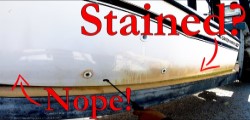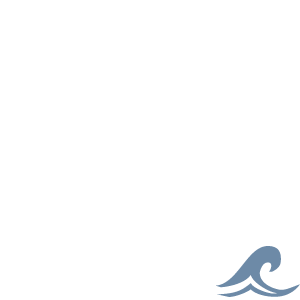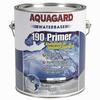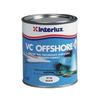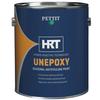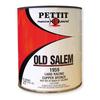
Anti-fouling bottom paint can help keep your boat's hull in good condition, prevent bottom fouling, and will help your boat move through the water faster and more efficiently.
Bottom fouling results from 3 primary causes:
-
Marine life -- Barnacles, zebra mussels, and other small marine critters attach themselves to your boat's bottom while it's sitting in its slip or at its mooring. The hard shelled creatures that grow on boat hulls are primarily filter feeders, meaning they grab bits of food that drift by in the current. A boat moored where there is a strong current flow will have more trouble with crusty critters on the hull than one in more stagnant waters
-
Plants -- Weeds and water plants can also attach themselves to the boat, most often near the waterline where there's plenty of sunlight
-
Algae (a.k.a. Slime) -- Algae can form a gooey mess on your boat's bottom, blooming rapidly and creating an environment that attracts other organisms. This creates a nasty, hard-to-clean bottom situation, and slows your boat tremendously when it's moving through the water.
Does Your Boat Need Anti-Fouling Bottom Paint?
In some places, hull fouling occurs so quickly that boats can only be left in the water a couple of days before noticeable (and difficult to remove) growth can occur, while in other places boats can be left longer without bottom paint. It is best to ask other boaters in your area about the common boat bottom fouling threats and how quickly they occur.
Types of Anti-Fouling Bottom Paint
Anti-fouling bottom paints use biocides, usually cuprous oxide or copper thiocyanate, to discourage marine organisms from growing on the hull. TBT (tributyltin) was a commonly used biocide, but is illegal for most common purposes now.
Ablative bottom paints are designed to be applied in a fairly thick layer that wears away like soap, constantly exposing fresh paint. Others are hard epoxy or vinyl paints impregnated with biocide, which leaches out and leaves the depleted paint on the hull. There are also a few made with TBT substitute tin-based biocides and others, and bottom paints made with no biocide at all that are so slick that organisms cannot attach themselves firmly and can be wiped off.
Questions you should consider:
-
How long will the paint last?
-
How will it affect speed and efficiency, both initially and over the lifespan of the paint?
-
Which bottom paints can be used on top of which others, or on inflatable boats or aluminum hulls?
Ablative & Soluble Copolymer Bottom Paints
The older ablative paints were made to wear away through friction as the boat moved through the water, and some of these paints are still available today, such as Interlux Bottomkote ACT and XXX. The problem with these paints is that water wears the paint away much more quickly in areas of high friction, such as the leading edge of the keel and waterline, leaving those areas exposed while there is still plenty of good paint on the rest of the hull.
Modern ablative paints with water soluble or self-polishing copolymers dissolve at a predictable rate, and are not as susceptible to friction wear so tend to wear more evenly and last longer. Paints such as Pettit Horizons and Interlux Micron CSC fall into this category of more advanced ablative type paints.
Hard Bottom Paints
Hard bottom paints like Pettit Unepoxy, Interlux Fiberglass Bottomkote and others are durable and can be made very smooth. It is possible to achieve and maintain a smoother finish with these bottom paints than with most ablative types and the paint is long-lasting.
The downsides of the hard paints are that many lose effectiveness when out of the water, and the paint will build up over time if not sanded down each time the boat is bottom painted. Also, hard paints are at their most effective immediately after launching, and are less toxic to marine growth over time as the poisons within the paint leach out. That means that after a year or so, a hard bottom is likely to need more scrubbing than an ablative bottom, which will still just need a light wipe to expose fresh paint with copper biocide.
High Performance Bottom Paints
Racing sailboats and powerboats frequently use special bottom paints with Teflon to minimize hull friction. Common choices for fresh water use are Interlux VC 17m, while salt water racers use Interlux VC Offshore. These paints are generally incompatible with other paints.
The racing paints must be applied correctly in thin layers, then wet sanded with increasingly fine sandpaper, then burnished with cloth or newspaper until it shines to produce their maximum performance finish.
Bottom Paint Alternatives
Bottom paints are amazing things to boaters, but have the potential to be harmful to the waters around us. While the relative harm they cause is probably much smaller than other forms of pollution around us, the marine environment is particularly sensitive. Bottom paints contain metals and polymers which can affect the environment in negative ways, and it is helpful to learn about the alternatives before purchasing paint which could harm marine life and the environment we so much enjoy. Please visit our Anti Fouling Alternatives page to learn more, and consider your "boating footprint" when purchasing anti fouling for next season!
The Future of Bottom Paint
Due to stronger environmental protection laws and advancing technologies, several products are headed down the pike. While many are currently only available to large freighters, these new products will indeed affect recreational boaters in the future as production costs drop and products become more affordable to the every day boater. We will keep an eye on these products for you!
Estimating Bottom Paint Coverage Requirements
Calculate the area needing paint. For a rough estimate of the area to be painted, multiply the length of your hull (LOA) by the beam and multiply by 0.85 (LOA x B x 0.85 = Area). Then multiply the area by the number of coats you've chosen to apply. The paint manufacturers normally include coverage area on the side of the can, and often on their web site.
Best Practices
-
Apply an extra coat to leading and trailing edges, waterline, trim tabs, outdrives, keel and rudder. High turbulence in these areas tend to wear paint faster.
-
Always use the specified amount! Undercoating might lead to a costly mid-season haul-out!

